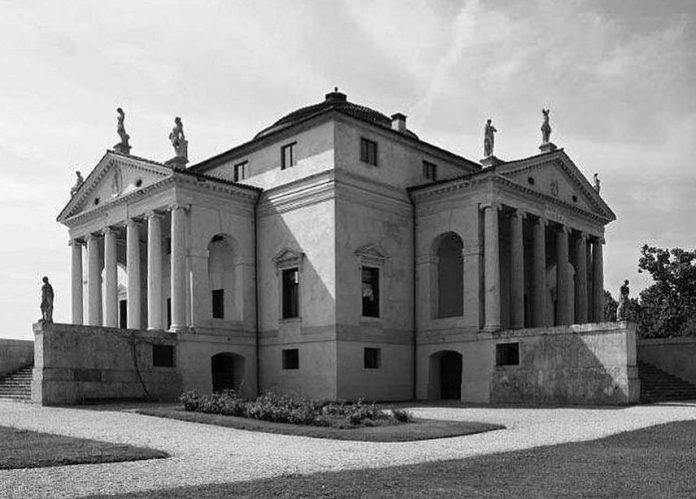Andrea Palladio was one of the most influential architects of all time. His distinctive, severely classical style was developed in 16th-century Italy, but it influenced architects all over Europe and in America for more than 200 years. The proportions, symmetry and grand entrance porticoes of Palladian buildings still seem to exude an aura of classical authority.
The architecture of the Renaissance, with its grounding in the orders and the ideas of Vitruvius, dominated the cityscapes of Italy in the 15th century and throughout the 16th. Renaissance architects such as Bramante and Alberti had a huge influence in Italy and beyond, as did Michelangelo, whose buildings formed just a part of his huge achievement. But in the 16th century another architect, Andrea Palladio, came to have a still broader influence.
Architect and writer
Palladio was born in Padua and first worked as a stonemason in Vicenza. Here he caught the eye of a humanist aristocrat, Giangiorgio Trissino, who educated him and took him to Rome to study the buildings of the ancient Romans. Back in Vicenza and the surrounding region he was soon designing palaces and country houses for the North Italian nobility. In addition he became a writer, recording the ancient buildings he saw in Rome in Le antichità di Roma (the first proper guidebook to the city’s Roman remains) and publishing I quattro libri dell’architettura (The Four Books of Architecture), which became one of the most influential architectural textbooks of all time.
Like his predecessors Alberti and Bramante, Palladio was a classical architect heavily influenced by the ideas of Vitruvius and the buildings of ancient Rome. But his buildings had several key features that were widely imitated later—his plans were meticulously symmetrical, his proportions were based on the principles of musical harmony and, since no Roman houses survived for later architects to copy, he created his own special form of house—the villa—with frontages based on Roman temples.
“Vitruvius is my master, Rome is my mistress, and architecture is my life.” Andrea Palladio
There was a ready clientele for Palladio’s buildings in northern Italy. He designed many buildings in Vicenza, from palazzi to the famous Teatro Olimpico, a theater with a built- in stage set (designed by Palladio’s follower Scamozzi) based on a perspective view of an ideal Renaissance city. But most famous were his villas, country houses in the Veneto region of Italy, buildings that were copied widely. He also built churches in Venice. But because of his writings, his influence spread far beyond northern Italy.
The villa
Palladio’s villas are compact country houses outside Venice, built mostly for the younger sons of Venetian nobles. They were working farms, centered on houses of unsurpassed elegance. The entrance façade of a Palladian villa is dominated by a large columned portico. This is because Palladio had read in Vitruvius that Greek temples were based on house design. So Palladio thought that ancient Greek houses (which do not survive) must have looked like ancient Greek temples (which do) and therefore his own classical houses should be fronted with porticoes. Another key element of villa design was symmetrical planning. This meant that a room on the right was mirrored by an identically sized and shaped room on the left, and so on. Some of Palladio’s houses, such as the famous Villa Capra (below), are so symmetrical that they even have an entrance portico on each of the four sides.
The style spreads
The first great Palladian was the English architect Inigo Jones. When Jones went to Italy, which he visited twice, he explored the ancient monuments with Palladio’s guidebook in his hand. Back in England he determined to bring classical architecture to a London still full of timber-framed houses. Two of his London designs especially, the Banqueting House in Whitehall and the Queen’s House at Greenwich, show his success. The Queen’s House, in particular, with its rather severe symmetry, pale stone and formal layout, must have shocked Londoners. But after it, English architecture was never the same. In one form or another, classicism remained a powerful force in England until the 20th century.
Translating Palladio
The Palladian revival was fueled in part by numerous translations of Palladio’s books, which came out in England during the 18th century. The first was by an architect from Venice who settled in England, Giacomo Leoni, whose English translation of Palladio’s I quattro libri came out in 1716. But in 1738 a more accurate translation appeared. This was by Isaac Ware, a follower and protégé of Lord Burlington. Ware’s accuracy and his connection to Burlington made his translation the one approved by the Palladians in Britain.
Under the auspices of the successful classical architect Elias Holl, Palladian ideas spread to Germany. The style also became fashionable in Holland, in the work of Jacob van Kampen, architect of the Mauritshuis, The Hague, and the grand Town Hall (later the Royal Palace) of Amsterdam. Like Jones and Holl, van Kampen had been to Italy and there he had probably met Vincenzo Scamozzi, an architect who had known Palladio and who completed several of Palladio’s works, including the Teatro Olimpico, on the master’s death.
These 17th-century Palladians were influential, but the ideas of Palladio had even more impact in the 18th century, especially in Britain, where architects such as Colen Campbell and Lord Burlington were especially attracted to Palladio’s villas, and two very close imitations of the Italian’s Villa Capra, near Vicenza, were built at Mereworth Castle, Kent, and Chiswick House, London, which Burlington built to show off his art collection. Many other symmetrically planned, severely classical, portico-fronted houses appeared, cementing Palladio’s influence in Britain in the first half of the 18th century. Germany and Russia caught the bug of Palladianism from Britain and the movement also influenced Thomas Jefferson, architect and president of the USA. From small beginnings in part of northern Italy, the reach of the Palladian style had become global.
